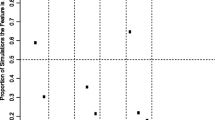Abstract
Aberrations in chromosome 8 are common in breast cancer. However, the relationship between numerical aberrations of chromosome 8 and clinical behavior (especially prognosis) in breast cancer is not well understood. In this study, a total of 40 specimens of stage II invasive ductal carcinomas (IDCs) was analyzed by fluorescence in situ hybridization (FISH) with a chromosome 8 centromere-specific probe and DNA flow cytometry (stage IIA: 20 cases; stage IIB: 20 cases). All cases were followed for at least 5.7 yr (mean: 7.5 yr; median: 7.7 yr) after surgery or until death. Single (loss), double, and triple or more signals (gain) of chromosome 8 were found in 7.6±3.5% (range: 2–16%; median: 7%), 53.7±13.2% (range: 25–81%, median: 53%), and 38.7±13.2% (range: 17–65%, median: 38%), respectively, of tumors. The frequencies of chromosome 8 gain and disomy correlated with patient outcome (respectively p<0.05 and p<0.01). When median ratios of chromosome 8 loss, disomy, and gain were used as the cutoff values, the survival curves revealed that patients in the low-frequency group survived significantly longer than those in the high-frequency group for chromosome 8 gain (p<0.05), and patients in the high-frequency group survived significantly longer than those in the low-frequency group for chromosome 8 disomy (p<0.05). Poor prognosis was not associated with age, tumor size, lymph node metastasis, histologic type, TNM stage, estrogen-receptor status, progesterone-receptor status, or DNA ploidy. Our results suggest that the frequencies of chromosome 8 gain and disomy is a potentially useful parameter for predicting prognosis of stage II IDCs.
Similar content being viewed by others
References
Stanford, J.L., Szklo, M. and Brinton, L.A. (1986). Estrogen receptor and breast cancer. Epidemiol. Rev. 8:42–56.
Slamon, D.J., et al. (1987). Human breast cancer: correlation of relapse and survival with amplification of the HER-2/neu oncogene. Science 235:177–182.
Forozan, F., Karhu, R., Kononen, J. and Kallioniemi, O.P. (1997). Genome screening by comparative genomic hybridization. Trends Genet. 13:405–409.
Isola, J.J., et al. (1995). Genetic aberrations detected by comparative genomic hybridization predict outcome in node-negative breast cancer. Am. J. Pathol. 147:905–911.
Kallioniemi, O.P., et al. (1994). Optimizing comparative genomic hybridization for analysis of DNA sequence copy number changes in solid tumors. Genes Chromosom. Cancer 10:231–243.
Ried, T., et al. (1995). Comparative genomic hybridization of formalin-fixed, paraffin-embedded breast carcinomas reveals different patterns of chromosomal gains and losses in fibroadenomas and diploid and aneuploid carcinomas. Cancer Res. 55:5415–5423.
Nishizaki, T., et al. (1997). Genetic alterations in lobular breast cancer by comparative genomic hybridization. Int. J. Cancer 74:513–517.
Tirkkonen, M., et al. (1998). Molecular cytogenetics of primary breast cancer by CGH. Genes Chromosom. Cancer 21:177–184.
Roylance, R., et al. (1999). Comparative genomic hybridization of breast tumors stratified by histological grade reveals new insights into the biological progression of breast cancer. Cancer Res. 59:1433–1436.
Buerger, H., et al. (1999). Different genetic pathways in the evolution of invasive breast cancer are associated with distinct morphological subtypes. J. Pathol. 189:521–526.
Escot, C., et al. (1986). Genetic alteration of the c-myc protooncogene (MYC) in human primary breast carcinomas. Proc. Natl. Acad. Sci. USA 83:4834–4838.
Visscher, D.W., Wallis, T., Awussah, S., Mohamed, A. and Crissman, J.D. (1997). Evaluation of MYC and chromosome 8 copy number in breast carcinoma by interphase cytogenetics. Genes Chromosom. Cancer 18:1–7.
Nesbit, C.E., Tersak, J.M. and Prochownik, E.V. (1999) MYC oncogenes and human neoplastic disease. Oncogene 18:3004–3016.
Devilee, P. and Cornelisse, C.J. (1994). Somatic genetic changes in human breast cancer. Biochem. Biophys. Acta 1198:113–130.
Lichter, P., Cremer, T., Borden, J., Manuelidis, L. and Ward, D.C. (1988). Delineation of individual human chromosomes in metaphase and interphase cells by in situ suppression hybridization using recombinant DNA libraries. Hum. Genet. 80:224–234.
Matsumura, K., et al. (1992). Deletion of chromosome 17p loci in breast cancer cells detected by fluorescence in situ hybridization. Cancer Res. 52:3474–3477.
Matsuyama, H., et al. (1994). Deletion mapping of chromosome 8p in prostate cancer by fluoresence in situ hybridization. Oncogene 9:3071–3076.
Afify, A. and Mark, H.F.L. (1997). Fluorescent in situ hybridization assessment of chromosome 8 copy number in stage I and stage II infiltrating ductal carcinoma of the breast. Cancer Genet. Cytogenet. 97:101–105.
Mark, H.F.L., et al. (1997). Stage I and stage II infiltrating ductal carcinoma of the breast analyzed for chromosome 8 copy number using fluorescent in situ hybridization. Pathobiology 65:184–189.
Fleming, I.D., et al. (eds.) (1997). American Joint Committee on Cancer Staging Manual, 5th ed. JB Lippincott, Philadelphia.
Pinkel, D., Straume, T. and Gray, J.W. (1986). Cytogenic analysis using quantitative, high-sensitivity, fluorescence hybridization. Proc. Natl. Acad. Sci. USA 83:2934–2938.
Kovach, J.S., et al. (1991). Direct sequencing from touch preparations of human carcinomas: analysis of p53 mutations in breast carcinomas. J. Natl. Cancer Inst. 83:1004–1009.
Hopman, A.H.N., et al. (1988). In situ hybridization as a tool to study numerical chromosome aberrations in solid bladder tumors. Histochemistry 89:307–316.
Terada, R., et al. (1999). Higher frequencies of numerical aberrations of chromosome 17 in primary gastric cancers are associated with lymph node metastasis. J. Gastroenterol. 34:11–17.
Terada, R., et al. (2002). Clinical significance of nm23 expression and chromosome 17 numerical aberrations in primary gastric cancer. Med. Oncol. 19, 239–248.
Pinto, A.E., Andre, S. and Soares, J. (1999). Short term significance of DNA ploidy and cell proliferation in breast carcinoma: a multivariate analysis of prognostic markers in a series of 308 patients. J. Clin. Pathol. 52:604–611.
Arnoldus, E.P.J., et al. (1991). Feasibility of in situ hybridization with chromosome specific DNA probes on paraffin wax-embedded tissue. J. Clin. Pathol. 44:900–904.
Author information
Authors and Affiliations
Corresponding author
Rights and permissions
About this article
Cite this article
Tagawa, Y., Yasutake, T., Ikuta, Y. et al. Chromosome 8 numerical aberrations in stage II invasive ductal carcinoma. Med Oncol 20, 127–135 (2003). https://doi.org/10.1385/MO:20:2:127
Received:
Accepted:
Issue Date:
DOI: https://doi.org/10.1385/MO:20:2:127




